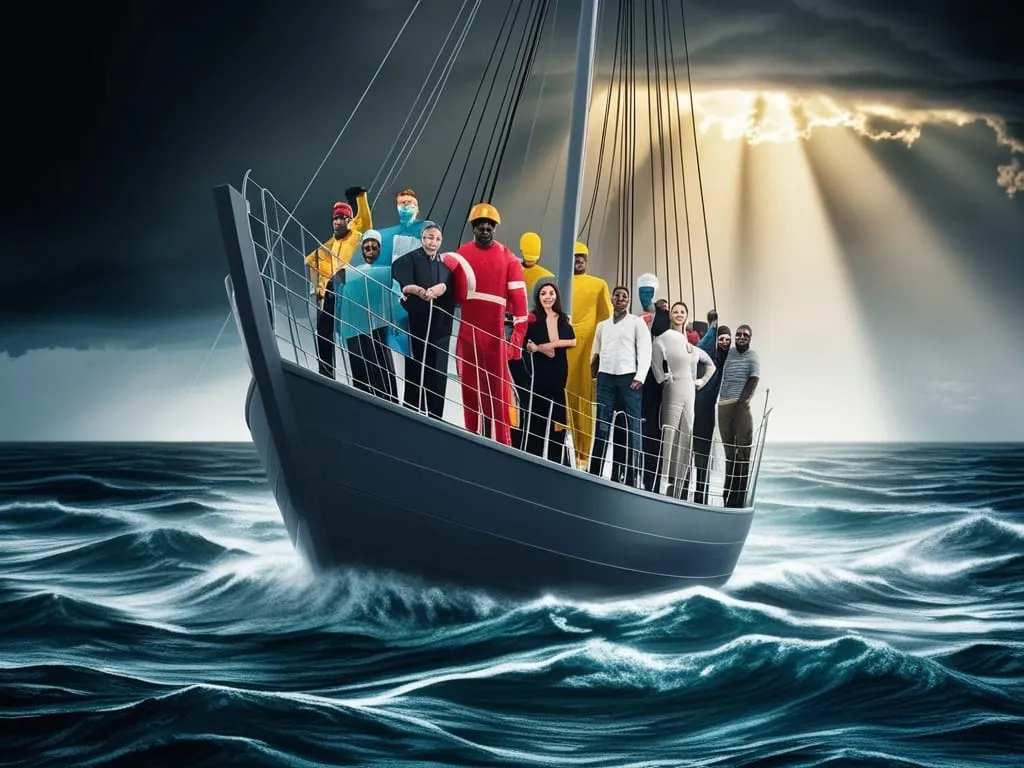Leadership is an art, and fostering healthy competition within a team is one of its most delicate brushstrokes. As leaders, we often find ourselves walking a tightrope between encouraging individual excellence and maintaining team harmony. But when done right, competition can be the catalyst that propels a team to new heights of innovation and productivity.
Let’s start by dispelling a common myth: competition and collaboration are not mutually exclusive. In fact, they can be two sides of the same coin. The key lies in creating an environment where team members are motivated to excel individually while still working towards collective goals.
One of the first steps in cultivating healthy competition is establishing clear performance metrics. These metrics serve as guideposts, giving team members a concrete understanding of what success looks like. However, it’s crucial to ensure these metrics are fair, achievable, and aligned with the organization’s overall objectives.
“The way a team plays as a whole determines its success. You may have the greatest bunch of individual stars in the world, but if they don’t play together, the club won’t be worth a dime.” - Babe Ruth
This quote from the legendary Babe Ruth underscores the importance of team cohesion, even in the face of individual brilliance. How can we, as leaders, ensure that our performance metrics foster both individual growth and team success?
One effective approach is to design team-based challenges. These challenges can create a sense of shared purpose and encourage collaboration, even as individuals strive to contribute their best. For instance, you might set a team goal for a project and then recognize both the top individual performers and the team as a whole upon successful completion.
But how do we strike the right balance between competition and collaboration? This is where the real art of leadership comes into play. It’s about creating an atmosphere where team members feel comfortable sharing ideas and supporting each other, even as they push themselves to excel.
“Competition has been shown to be useful up to a certain point and no further, but cooperation, which is the thing we must strive for today, begins where competition leaves off.” - Franklin D. Roosevelt
Roosevelt’s words remind us that while competition can drive progress, cooperation is the foundation of lasting success. As leaders, we must be vigilant in monitoring the team dynamic, ready to adjust our approach if competition begins to erode teamwork.
Providing real-time feedback is another crucial practice in fostering healthy competition. This doesn’t mean constant surveillance or micromanagement. Rather, it’s about creating open channels of communication where team members can receive timely input on their performance and progress.
Real-time feedback serves multiple purposes. It helps individuals understand where they stand in relation to their goals, allows for quick course corrections, and can boost motivation by acknowledging achievements promptly. Moreover, when done transparently, it can foster a culture of continuous improvement across the entire team.
But feedback isn’t just about pointing out areas for improvement. It’s equally important to celebrate successes, both big and small. This brings us to the next key practice: establishing fair reward systems.
A well-designed reward system can be a powerful motivator, but it must be perceived as fair by all team members. This means rewards should be clearly linked to performance metrics and team goals. They should also be diverse, recognizing different types of contributions to the team’s success.
“I have been up against tough competition all my life. I wouldn’t know how to get along without it.” - Walt Disney
Disney’s quote highlights an often-overlooked aspect of competition: its role in personal growth. How can we, as leaders, ensure that our team members view competition as an opportunity for growth rather than a threat?
One way is to promote learning from outcomes, both successes and failures. This involves creating a culture where mistakes are seen as learning opportunities and where team members are encouraged to share their insights and experiences.
When a project or initiative concludes, whether successfully or not, take the time to conduct a thorough debrief. What went well? What could have been done differently? How can these lessons be applied to future endeavors? By framing these discussions in terms of learning and improvement rather than blame or praise, we can help our teams develop a growth mindset.
It’s also important to remember that healthy competition doesn’t always have to be about outperforming others. Sometimes, the most powerful competition is with oneself. Encourage team members to set personal goals and celebrate when they surpass their own previous bests.
“The principle is competing against yourself. It’s about self-improvement, about being better than you were the day before.” - Steve Young
Young’s words encapsulate a powerful truth: the most sustainable form of competition is the drive to continually improve oneself. How can we foster this mindset in our teams?
One effective strategy is to encourage skill-sharing within the team. When team members teach and learn from each other, it creates a culture of mutual growth and respect. It also helps to break down silos and fosters a more collaborative environment, even as individuals strive to excel in their areas of expertise.
As leaders, we must also be mindful of the potential downsides of competition. When taken to extremes, it can lead to stress, burnout, and a breakdown in team cohesion. Regular check-ins with team members, both individually and as a group, can help us gauge the team’s emotional temperature and adjust our approach as needed.
Remember, the goal of fostering healthy competition is not to create a cutthroat environment where team members see each other as rivals. Rather, it’s about harnessing the natural human drive to excel and channeling it towards collective success.
“The healthiest competition occurs when average people win by putting in above-average effort.” - Colin Powell
Powell’s insight reminds us that effort, not just innate talent, should be recognized and rewarded. How can we design our performance metrics and reward systems to acknowledge both results and the effort that goes into achieving them?
One approach is to incorporate process-based metrics alongside outcome-based ones. For example, in addition to tracking sales numbers, you might also recognize team members who consistently follow up with clients or who develop innovative approaches to problem-solving.
It’s also crucial to lead by example. As leaders, we should embody the spirit of healthy competition we wish to see in our teams. This means being open about our own goals and challenges, celebrating our team’s successes more vocally than our own, and demonstrating a willingness to learn and grow.
In conclusion, fostering healthy competition is about creating an environment where team members are inspired to give their best, not out of fear or rivalry, but out of a genuine desire for personal and collective growth. It’s about harnessing the power of competition while maintaining the strength of collaboration.
By implementing clear performance metrics, designing team-based challenges, balancing competition with collaboration, providing real-time feedback, establishing fair reward systems, and promoting learning from outcomes, we can create a dynamic and positive team culture. One where competition serves as a rising tide that lifts all boats, driving innovation, productivity, and team growth.
Remember, the ultimate competition is not with each other, but with our own potential. As leaders, our role is to create the conditions where every team member can strive to be their best self, contributing to a whole that is greater than the sum of its parts. In doing so, we not only foster healthy competition but also build teams that are resilient, innovative, and primed for success.






